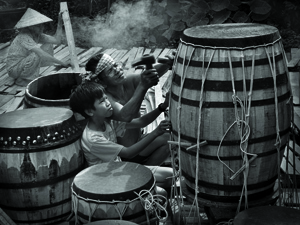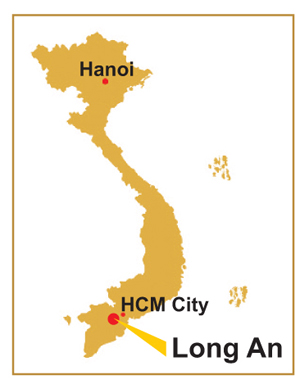(No.4, Vol.7,Aug-Sep 2017 Vietnam Heritage Magazine)




Photos by Nguyen Huu Tuan at a workshop making drum in the Binh An Trade Village, Long An Province
A brief history of buffalo-skin drums
The drum trade at Binh An Village, Binh Lang Commune, in the Tan Tru District, Long An Province, took form nearly 200 years ago. According to artisan Nguyen Van Men, his great grand father Mr Nguyen Van Ty was the founder of the Binh An drum trade. About 200 years ago, Mr Nguyen Van Ty used a big boat to take fish sauce to sell at Rach Gam-Xoai Mut market in Tien Giang Province. Once, paddling on a canal and seeing buffalo skin trashed by a slaughterhouse floating on the water, he took it home and sundried it. After many experiments, he succeeded in making his first drums.
At first, due to his lack of skills, the drum shape was husky and the sound was rough. Yet somehow he managed to sell a few of his drums to some temples and pagodas. Since then, as the fish sauce trade was not profitable, he gradually changed to making drums for sale, and founded the drum trade of Nguyen family of Binh An. For years, the techniques remained almost the same, without any big progress. Decades later, Mr Men’s father, Mr Nguyen Van Tinh made some significant breakthroughs. Mr Tinh found a technique of using frames to shape the barrel and buffalo skin cords to reinforce it, making well-formed, well-stretched drums which emit much better sounds. Since then, the family trade began to attract many orders from pagodas, temples, schools, music orchestras, etc. Today, the fifth generation of this family has turned Binh An into a drum-making trade village.
Binh An drum making consists of many steps. First, one needs to make the barrel. In the past Binh An folks used to buy a whole log, cut it into sections, bore out the inner part, and then cover the faces with buffalo skin.
Nowadays, as big logs are harder and harder to find, only small-diameter drums such as bowl drums, battle drums, rice drums, command drums and hip drums are made by gutted small wooden logs. To make big drums for temples, pagoda and big shows, today’s artisans joint thingan wood planks into barrels which can produce as high quality sound as the monolithic ones. They buy thingan wood, cut it into planks, heat them above fire and bend them. They whittle the two ends of each bent plank to make them narrower, joint them around rattan or steel frames and then fix them from outside to make a barrel. The form of the barrel depends on the sound requirements and the later use of the drum. Used in a school, the drum sound should be softer, so the planks are bent less and the barrels are more elongated. The drums used in temples, on the other hand, must produce thunderous, far-reaching sound, and so the barrels must be shorter, with a fatter belly.
The next step is to process the skin. They begin with fresh whole buffalo skin, never ox skin or salted skin. Although easy to preserve, dry salted skin tears and breaks more easily. Worse yet, drum faces made of salted skin sounds stiff in dry weather and stifled when humid. Before buying skin, the head master must make sure there will be plenty of sunny days ahead. Then somebody would be sent to buffalo slaughter houses in Ho Chi Minh City at 1-2 a.m. to buy fresh skin and bring it back home before sunrise. They clean the hair on the outside and the fat on the inside of the skin with razor-sharp knives. Then the skin is sundried for a week to ten days.
After that, the drum maker cuts a round piece of dry skin, a few inches wider than the face of the drum being made, and uses a sharp knife to adjust the thickness of different areas. This is the most difficult part of the job, one which requires great skill and care. The bigger the drum face, the thicker the skin should be. In an orchestra with ‘literary’ and ‘martial’ drums, a literary drum face should be thinner than that of the martial ones. The harder barrels are covered with thicker face skin, while thinner, not-so-tough barrels come with a thinner skin face. Also, the centre part where drumsticks strike must be thicker than the rims.
The well-formed piece of the drum face is sundried a few more days. Then it is soaked in water to become pliant. Holes are made along its rim. The skin is then put on to cover the barrel face. The maker uses cords, also cut from buffalo skin, to thread through the holes and pulls to stretch the drum face. According to Master Nguyen Van Men, buffalo skin strings are the best material for this purpose.
Then the barrel is cleaned, sanded, and coated with a mixture of sulphur and starch to fill up the slits, making the barrel surface smooth and able to absorb paint better.
As the coat dries, the barrel is painted. Traditionally, only red and black paints are used. However, Binh An artisans break the rule to bring drums a new modern face.
The last step is to decorate the drum. Binh An artisans usually paint the symbol of Yin and Yang on the drum face with red and black paint. It is a beautiful symbol, and it also guides the drummer where to strike to get the best sound. On the barrel of drums used for lion dances and that of tambourines, they may paint colourful dragons and clouds as ordered.
In the course of five consecutive generations, Binh An drum makers made many advancements in the techniques. Today, Binh An trade village is making all sorts of drums for all kinds of purposes, applications and clienteles. From religious sanctuaries to community centres, from schools to theatres, from music bands to liondance groups, from military signal drums to those used in superstitions practices, from drums of different regions of Vietnam (Can Tho, My Tho and Ben Tre) to those of different Chinese tribes (Trieu Chau, Quang Dong) the masters of Binh An know how to fine tune their drums to satisfy the choosiest of clients. As the good fame of Binh An trade village spreads, so does the product. The drums have found the way to all corners of Vietnam and further abroad, and their admirers have found a way to Binh An.

*The author is a lecturer of College of Culture and Art of Ho Chi Minh City

